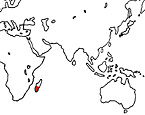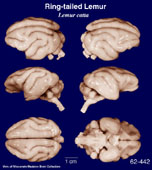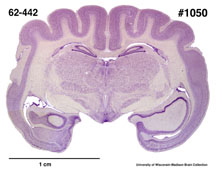|
Ring-tailed
Lemur
(Lemur catta) #62-442 |
||||
|
|
Physical
characteristics and distribution
|
|
Ring-tailed
Lemurs are adept at arboreal travel, but are partly terrestrial
and are found further into the interior highlands than any
other lemur. Males have scent glands on their wrists which
they rub onto their tails. They use this scent to establish
dominance when confronted by other males. The length of
the head and body is from 385-455 mm and the tail is 560-624
mm. Weight averages between 2.3 - 3.5 kg. Both sexes are
brownish gray with whitish underparts and a distinctly striped
black and white tail. The bottoms of all four feet are smooth
and leatherlike and the great toe is small compared to other
species of lemur. They live in groups averaging 13 animals before births and 17 afterward. There is no clear leader overall, but females are dominant. Females also stay with the troop of their birth, while males leave to join other family groups. Mating occurs from April to June and births occur from August through October. Gestation is 136 days. Infants cling to the underside of the mother for the first two weeks and then rides on her back. Weaning takes place at about 5 months, but infants may take some solid food at two months. They are found S Madagascar. |
|
Description
of the brain
|
|
Animal
source and preparation
|
|
All
specimens collected followed the same preparation
and histological procedure.
|
Other Related Resources (websites and publications)
List of Specimens | Explore Collections | Brain Sections | Brain Evolution | Brain Development | Brain Circuitry | Brain Functions | Location and Use | Related Web Sites | Contact Us | Search MSU Database | Personnel | Home



